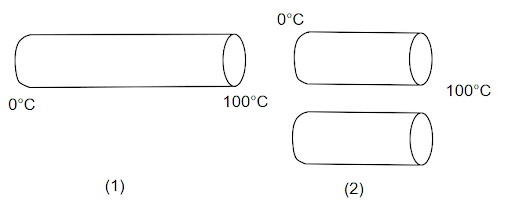
Two identical square rods of metal are welded end to end as shown in figure (1), 20 calories of heat flows through it in 4 minutes. If the rods are welded as shown in figure (2), the same amount of heat will flow through the rods in

A. 1 minute
B. 2 minute
C. 4 minute
D. 16 minute
Answer
220.2k+ views
Hint:The rate of heat flow is defined as the amount of heat that is transferred per unit of time in any material. It is usually measured in watts (or joules per second). To solve this problem, we compare the rate of heat flow when the length of the material will double and when the area of the material will double.
Formula used:
Heat flow rate is given as,
\[\dfrac{{dh}}{{dt}} = k \times A \times \left( {\dfrac{{dT}}{{dx}}} \right)\]
Where k is the thermal conductivity, A is the boundary surface area and \[\dfrac{{dT}}{{dx}}\] temperature gradient.
Complete step by step solution:
As we know that the heat flow rate is given as,
\[\dfrac{{dh}}{{dt}} = \dfrac{{k \times A \times \Delta t}}{l}\]
As for the figure (1), with double length, we have
\[\dfrac{{20}}{4} = \dfrac{{k \times A \times \Delta t}}{{2l}}\] ……1
for figure (2), with double length, we have
\[\dfrac{{20}}{t} = \dfrac{{k \times 2A \times \Delta t}}{l}\] …….2
Now dividing equations 1 and 2, we get
\[\dfrac{t}{4} = \dfrac{1}{4}\]
\[\therefore t = 4\]
Time, t = 4 minute
Therefore, the same amount of heat will flow through the rods in 4 minutes.
Hence option C is the correct answer.
Note: Heat transfer is the process in which there is the exchange of heat from a high-temperature body to a low-temperature body. As kinetic energy is the parameter included by the particles in the system. When the temperature of a system increases then the kinetic energy of the particle in that system will also increase.
Formula used:
Heat flow rate is given as,
\[\dfrac{{dh}}{{dt}} = k \times A \times \left( {\dfrac{{dT}}{{dx}}} \right)\]
Where k is the thermal conductivity, A is the boundary surface area and \[\dfrac{{dT}}{{dx}}\] temperature gradient.
Complete step by step solution:
As we know that the heat flow rate is given as,
\[\dfrac{{dh}}{{dt}} = \dfrac{{k \times A \times \Delta t}}{l}\]
As for the figure (1), with double length, we have
\[\dfrac{{20}}{4} = \dfrac{{k \times A \times \Delta t}}{{2l}}\] ……1
for figure (2), with double length, we have
\[\dfrac{{20}}{t} = \dfrac{{k \times 2A \times \Delta t}}{l}\] …….2
Now dividing equations 1 and 2, we get
\[\dfrac{t}{4} = \dfrac{1}{4}\]
\[\therefore t = 4\]
Time, t = 4 minute
Therefore, the same amount of heat will flow through the rods in 4 minutes.
Hence option C is the correct answer.
Note: Heat transfer is the process in which there is the exchange of heat from a high-temperature body to a low-temperature body. As kinetic energy is the parameter included by the particles in the system. When the temperature of a system increases then the kinetic energy of the particle in that system will also increase.
Recently Updated Pages
Two discs which are rotating about their respective class 11 physics JEE_Main

A ladder rests against a frictionless vertical wall class 11 physics JEE_Main

Two simple pendulums of lengths 1 m and 16 m respectively class 11 physics JEE_Main

The slopes of isothermal and adiabatic curves are related class 11 physics JEE_Main

A trolly falling freely on an inclined plane as shown class 11 physics JEE_Main

The masses M1 and M2M2 M1 are released from rest Using class 11 physics JEE_Main

Trending doubts
JEE Main 2026: Application Form Open, Exam Dates, Syllabus, Eligibility & Question Papers

Understanding Uniform Acceleration in Physics

Derivation of Equation of Trajectory Explained for Students

Hybridisation in Chemistry – Concept, Types & Applications

Understanding the Angle of Deviation in a Prism

How to Convert a Galvanometer into an Ammeter or Voltmeter

Other Pages
Thermodynamics Class 11 Physics Chapter 11 CBSE Notes - 2025-26

JEE Advanced Marks vs Ranks 2025: Understanding Category-wise Qualifying Marks and Previous Year Cut-offs

Units And Measurements Class 11 Physics Chapter 1 CBSE Notes - 2025-26

NCERT Solutions For Class 11 Physics Chapter 8 Mechanical Properties Of Solids

Motion in a Straight Line Class 11 Physics Chapter 2 CBSE Notes - 2025-26

Laws of Motion Class 11 Physics Chapter 4 CBSE Notes - 2025-26




